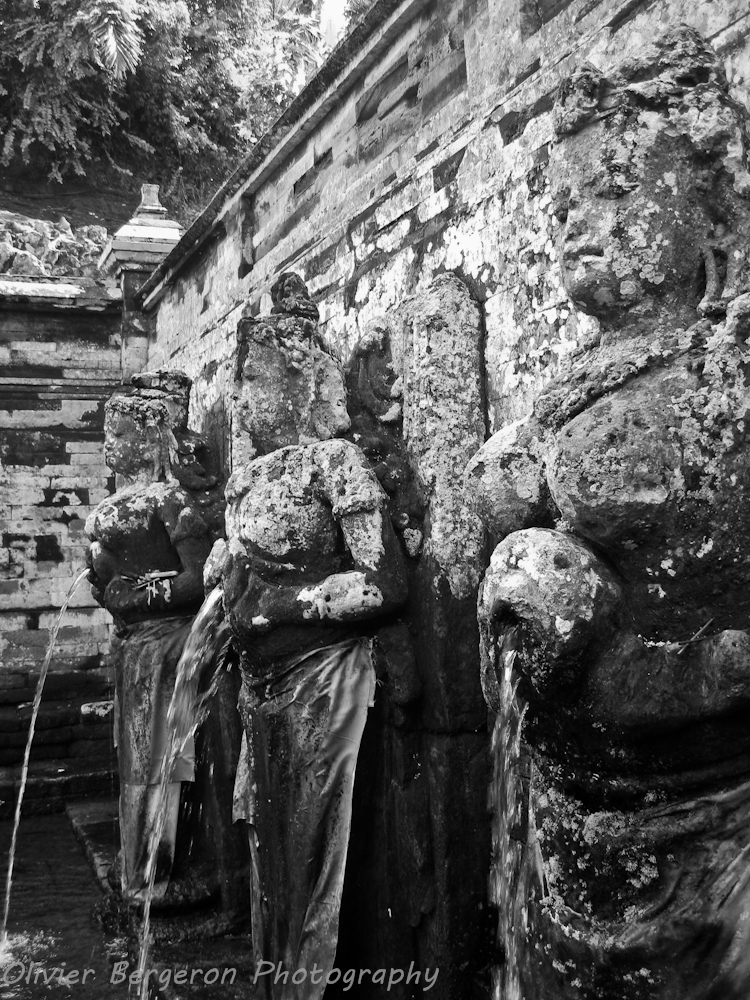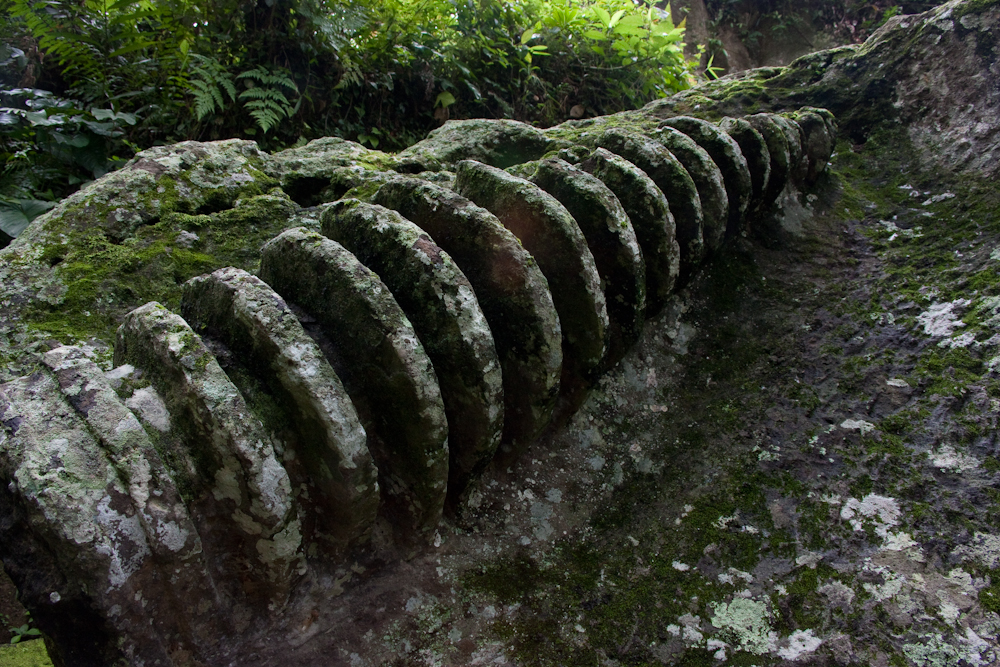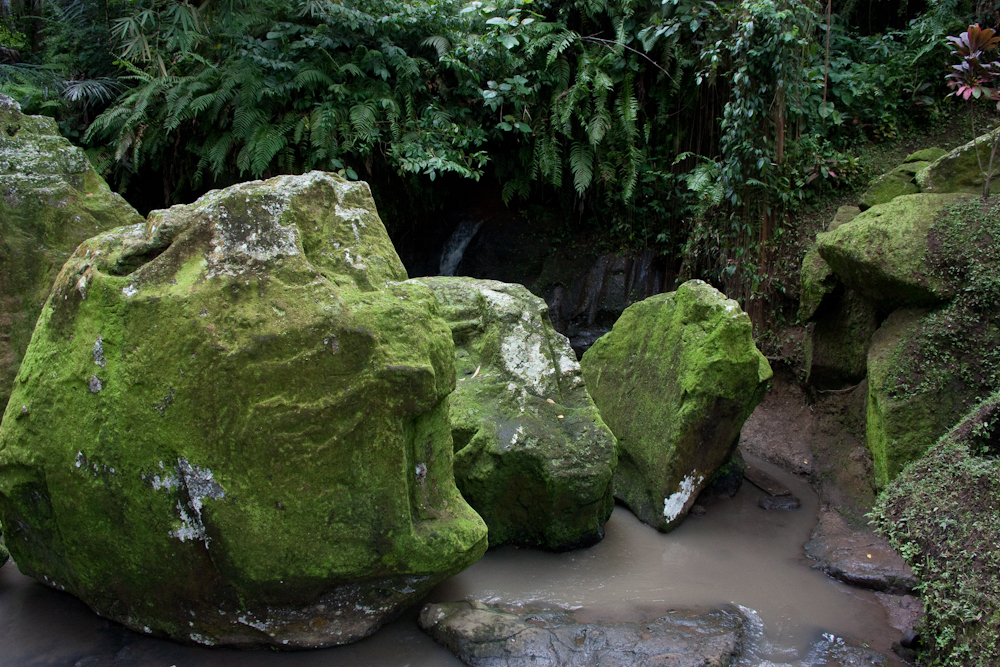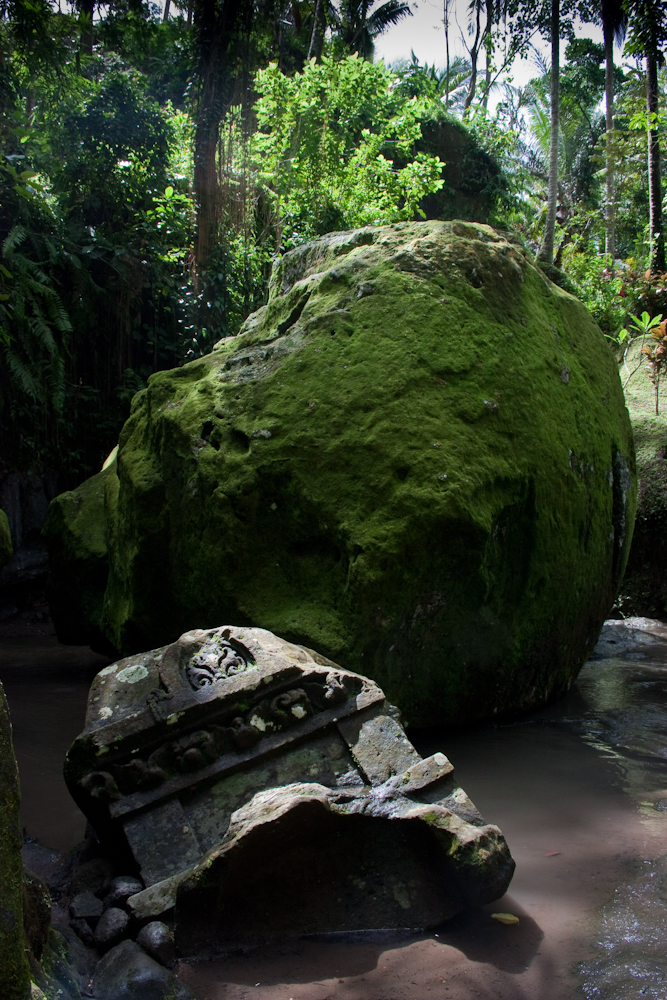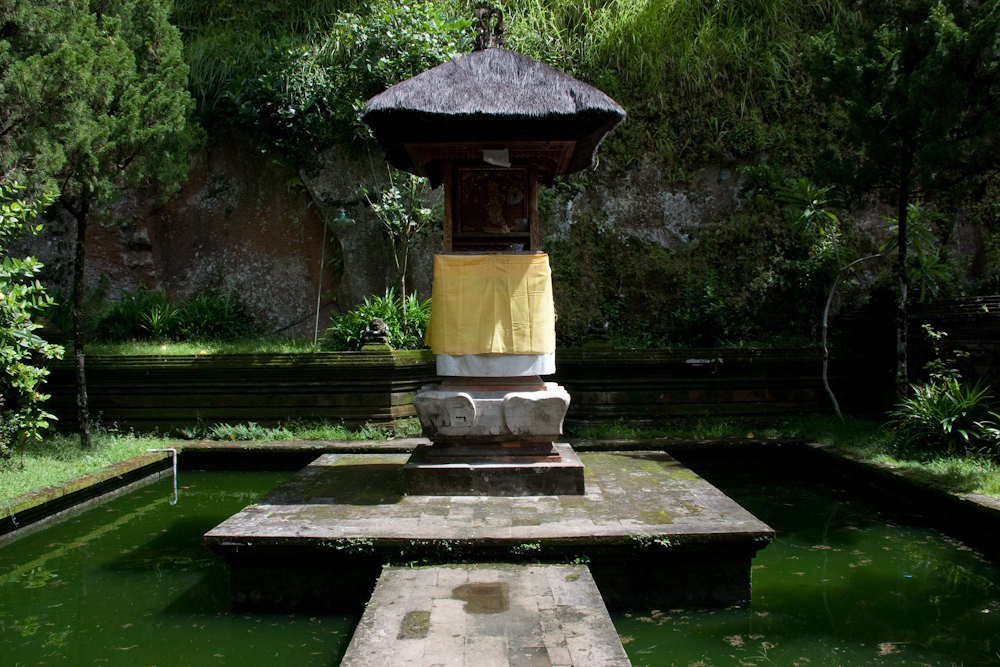Welcome to The Places To Visit In Bali guide. I visited Bali in 2010 on my honeymoon. In this guide, I make you discover the superb places that I had the opportunity to visit in this magnificent and very green islands.
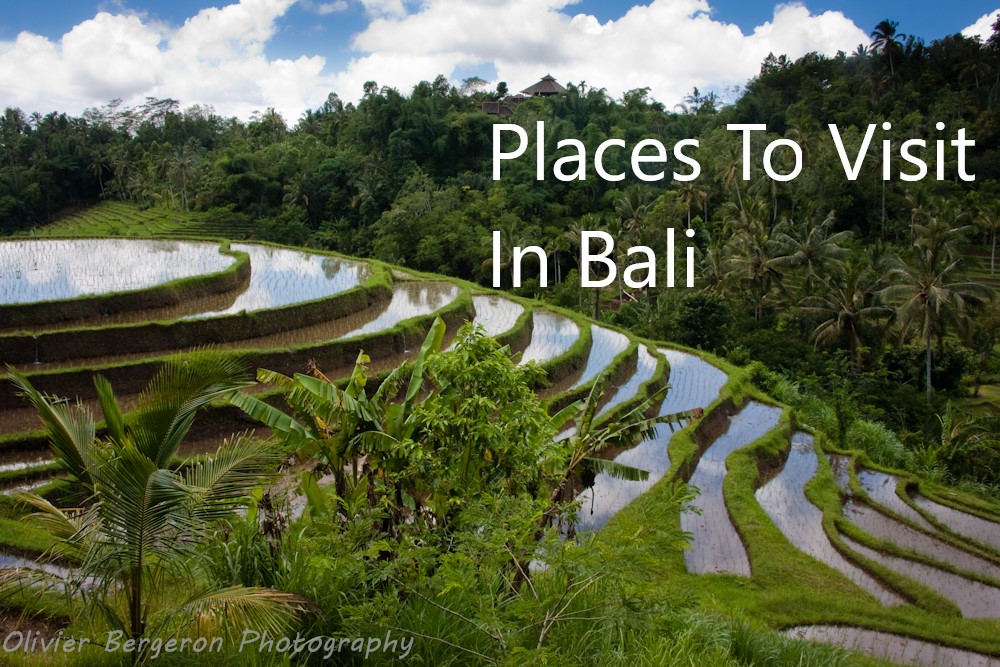
Table of contents
- Jatiluwih Rice Terrace
- Goa Gajah
- JL Raya Rice Terrace
- Besakih Temple
- Pura Ulun Danu Bratan
- Pura Tanah Lot
- Pura Batu Bolong
- Kerta gosa
- The pagoda of Mengwi – Pura Taman Ayun
- Gunung Kawi
- Tirta Empul
- Mount Batur
- Pura Luhur Batukaru temple
- Tegallalang Rice terrace
- Ubud
- Glossary
- Reference to Places to Visit In Bali
- Going more far
- FAQ Places to Visit in Bali
Jatiluwih rice terrace
Jatiluwih is a tourist village located in the Penebel subdistrict of the island of Bali. It offers beautiful panoramas accompanied by rice terraces, using the traditional Balinese irrigation known as subak. The air is cool as it is at an average altitude of 700 meters above sea level.
The Jatiluwih subaks as well as 4 other sites have been classified as UNESCO World Heritage. They represent the manifestation of the Tri Hita Karana philosophy which brings together the realms of the spirit, the human world and nature. This philosophy was born of the cultural exchange between Bali and India over the past 2,000 years and has shaped the landscape of Bali. The subak system of democratic and egalitarian farming practices has enabled the Balinese to become the most prolific rice growers in the archipelago despite the challenge of supporting a dense population.
A little precision, the air is cool as it is at an average altitude of 700 meters above sea level.
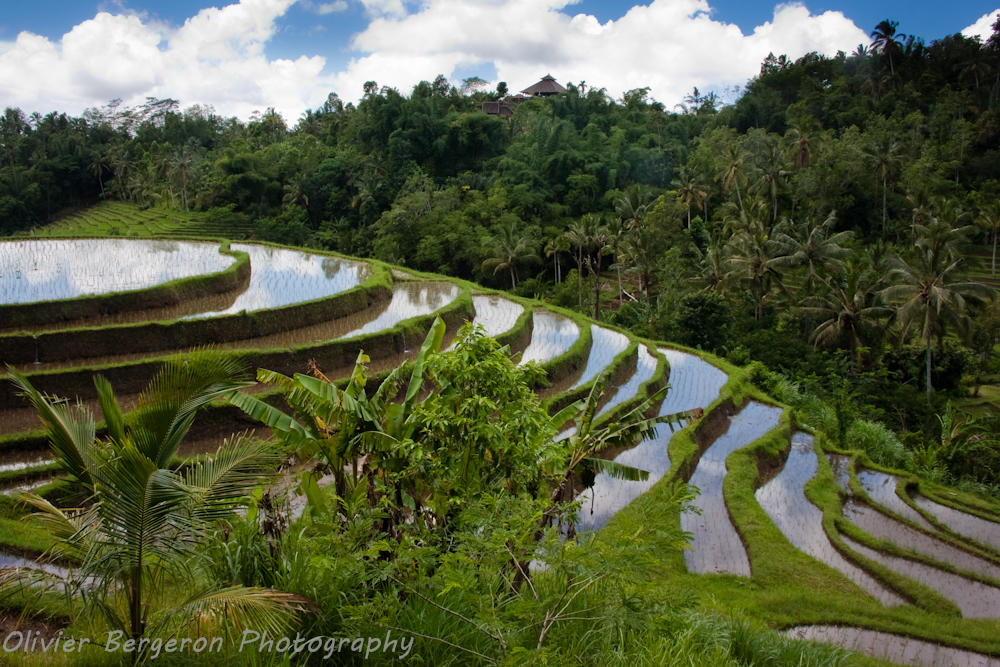
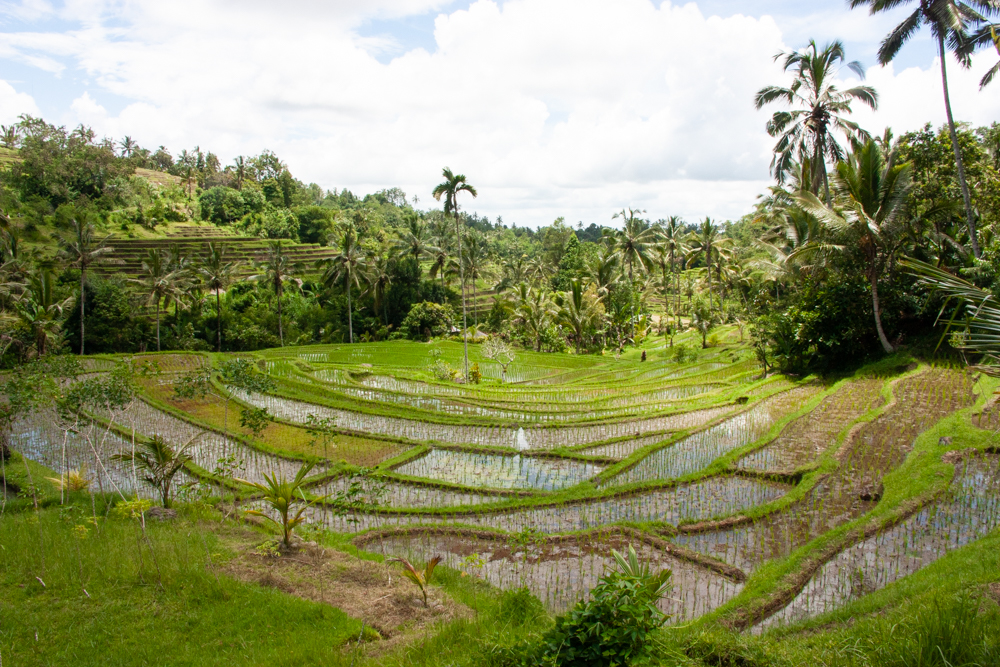
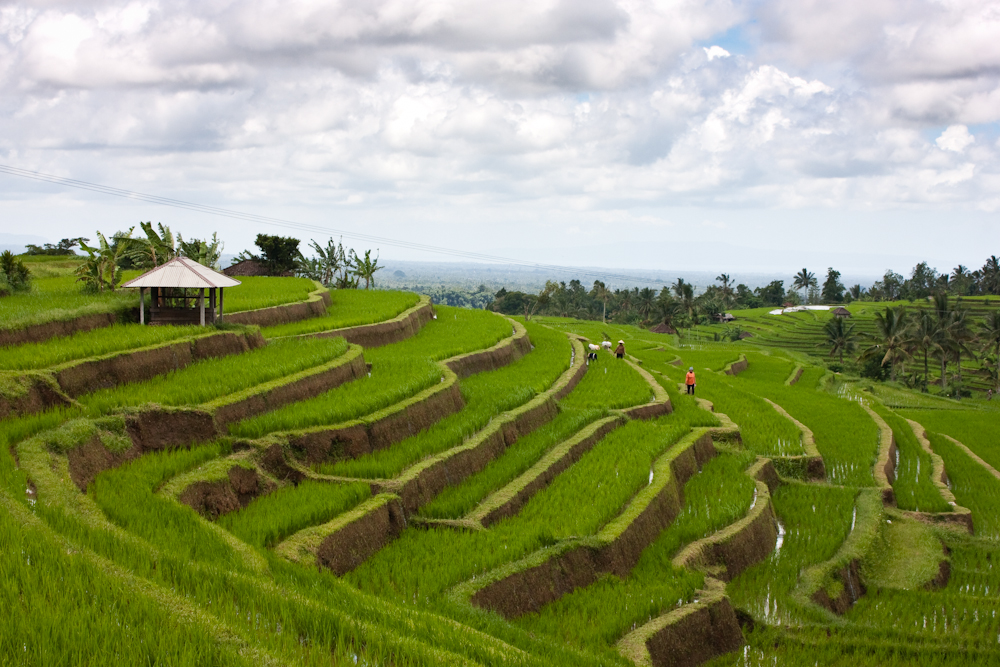
Goa Gajah
Wake up the Indiana Jones inside you. This temple is fascinating, especially the old destry ruins cover, by moss, inside the deep valley. The sanctuary was buit around the 9th century. Goa Gajah is located at the south-east of Ubud, very near this city (4-5 km). Built in the 9th century, it was perhaps first dedicated to Buddhist worship, before being transformed into a Hindu sanctuary.
The complex contains both Hindu and Buddhist artifacts, as the cave contains lingam and yoni, symbol of Shiva, and the image of Ganesha, while by the river there are carved images of stupas and chattra, imagery of Buddhism.
On the top of the site, the elephant cave, discovered by dutch archeologist in 1923, is decorated by a menacing figure, mistaken for an elephant. On one side there is a statue of Ganesh; on the other side, three statuettes represent Shiva lin
Still at the top of the site, rectangular baths and fountains remained buried until the 1950s. They are divided into two parts, each decorated with three statues of women carrying a vase at belly level, from which the water that feeds them comes out. . These baths date from the 11th century.
In the bottom of the valley, you can discover the imposing ruins, covered with moss, of the complex of Tukad Pangkung.
In 1931, Conrat Spies found significant remains in the Tukad Pangkung complex in the form of a three-pronged stupa carved into a rock face that had collapsed and lay at the bottom of Tukad Pangkung. 13-tiered umbrella-shaped stupas were also discovered there.

Fountain – Goa Gajah – Bali 
Goa Gajah – Bali 
Goa Gajah – Bali 
Goa Gajah – Bali 
Goa Gajah – Bali
JL Raya road – rice terrace
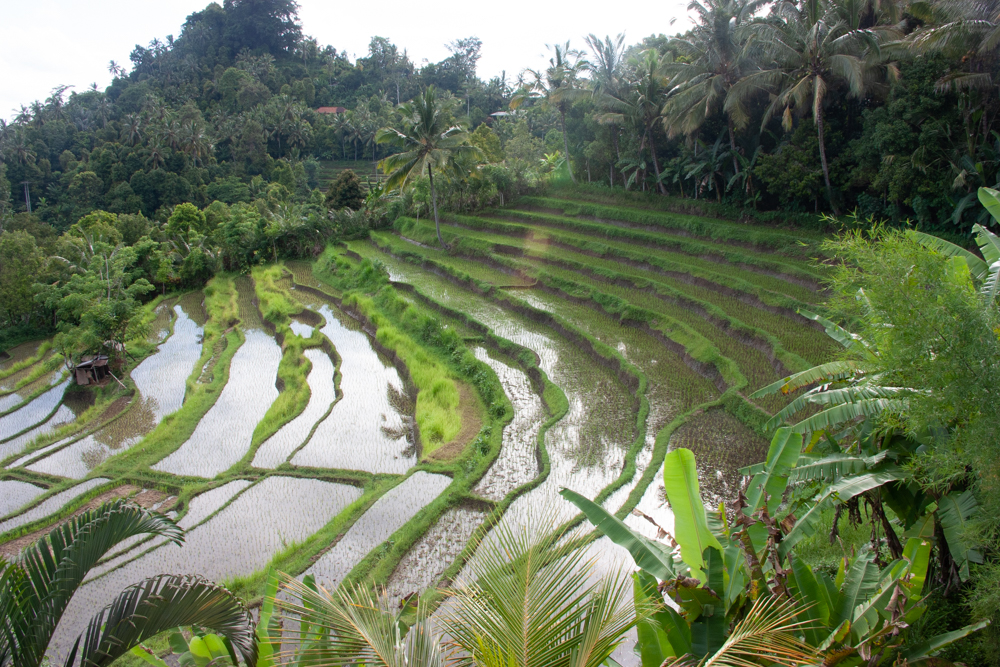
Besakih Temple
Located in the east of the island and on the slopes of the Mount Agung, an active volcano and the highest point of Bali with an elevation of 3031 meters having had its last eruption in 2019, the Pura Besakih Temple is a Balinese Hindhuism temple. His elevation above the sea is around 1km. It is considered the most important, the largest and holiest temple.
The temple is around 42 km from Denpasar.
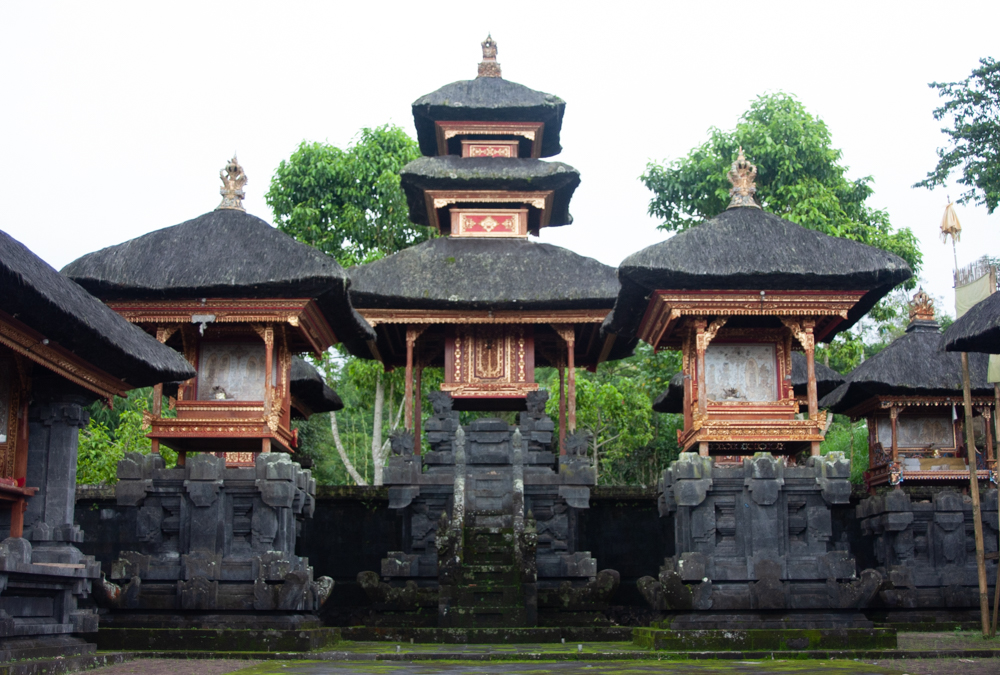
It is an extensive complex of 23 temples with the largest and most important being Pura Penataran Agung. The temple is built on six levels, terraced up the slope. The entrance is marked by a candi bentar or split gateway, and beyond it the Kori Agung is the gateway to the second courtyard.
The three main temples are : Pura Penataran Agung, Dedicated to Sang Hyang Widi Wasa : Pura Kiduling Kreteg, dedicated to Brahma; and Pura Batu Madeg, dedicated to Wisnu.
It has been regarded as a holy place since pre-historic times in Bali. The first recorded mention of its existence is from an inscription that dates from 1007 A.D. Since the Gelgel dynasty of the fifteenth century it has been regarded as a central, holy temple for the entire island.
The stone bases of Pura Penataran Agung and several other temples resemble megalithic stepped pyramids, which date back at least 2,000 years. The symbolic center of the main sanctuary is the lotus throne or padmasanaa, which is therefore the ritual focus of the entire complex. It dates to around the seventeenth century
A series of eruptions of Mount Agung in 1963 threatened Pura Besakih. The lava flows missed the temple complex by mere meters. The saving of the temple is regarded by the Balinese people as miraculous.
Each temple has its own odalan, or anniversary celebration, and on the full moon of the Balinese month “Kedasa” the entire compound of Besakih celebrates the visit of the gods, with an enormous throng of visiting pilgrims
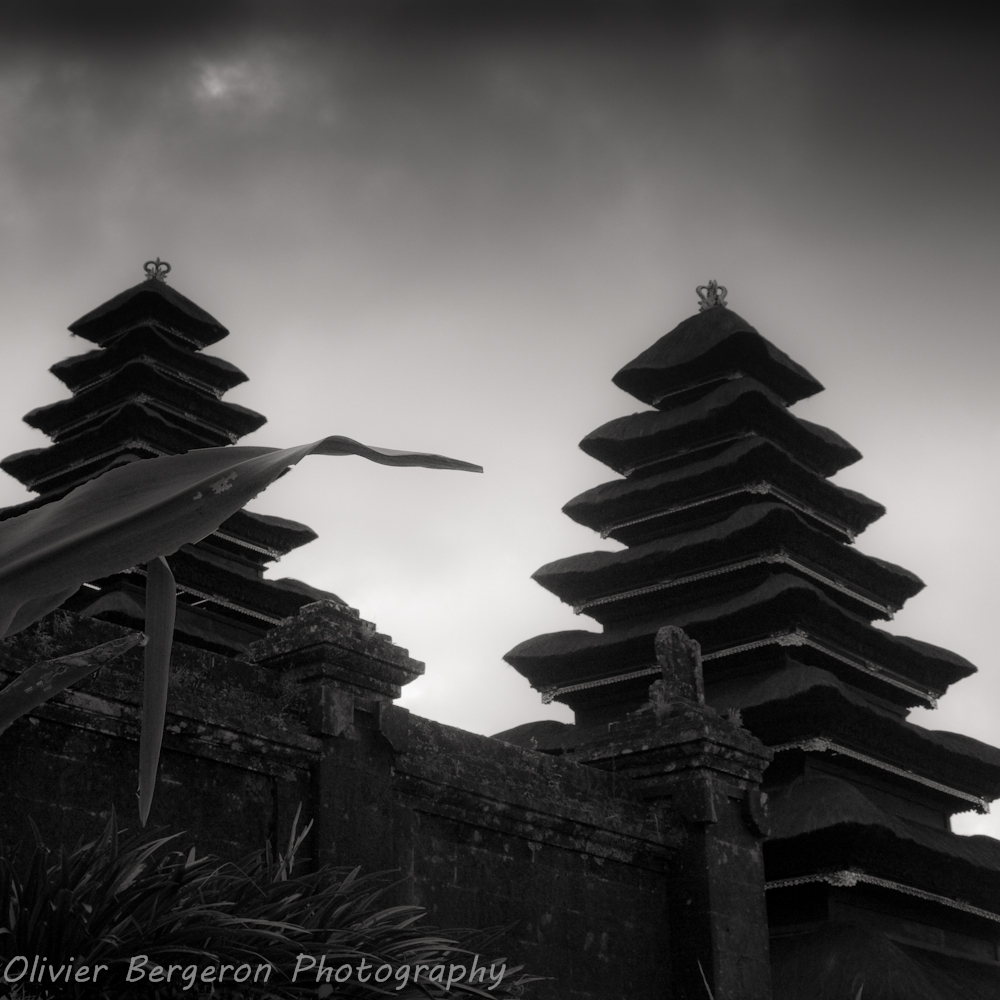
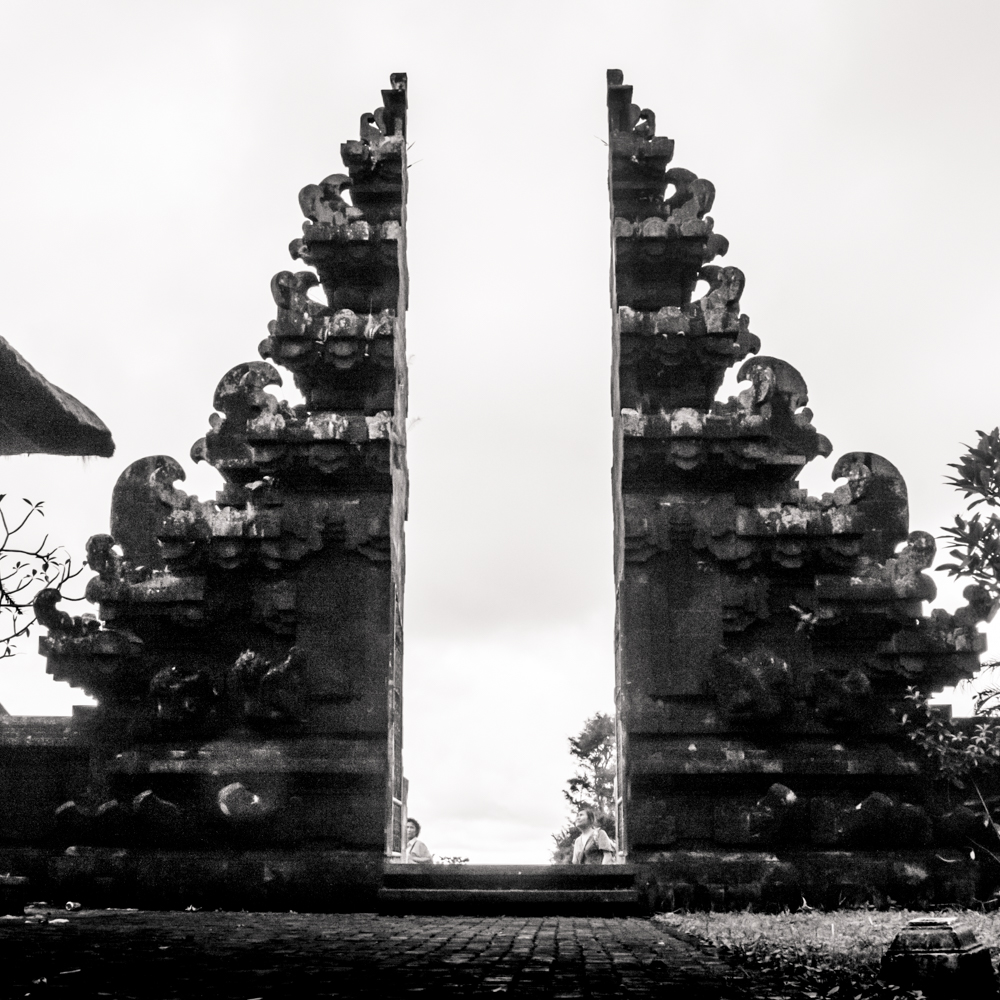
Pura : A pura is a Balinese Hindhu temple where the adherents of Balinese Hindhuism can practice their religion. They are built following the style, the rules ans the rituals of the Balinese architecture. Most puras are found on the island of Bali but can also be found in other parts of Indonesia. The term pura means « city », « walled city », « towered city », or « palace » in Sanskrit which has spread with Hindhuism in South-East Asia. After during the development of the Balinese language the term pura came to refer to a religious temple complex.
Balinese Hinduism is the form of Hinduism practised by the majority of the population of Bali. This is particularly associated with the Balinese people residing on the island, and represents a distinct form of Hindu worship incorporating local animism, ancestor worship or Pitru Paksha, and reverence for Buddhist saints or Bodhisattava.
Balinese temple or pura are designed as an open air place of worship within enclosed walls, connected with a series of intricately decorated gates between its compounds. This walled compounds contains several shrines, meru (towers), and bale (pavilions). The design, plan and layout of the pura follows the Tri Mandala concept of Balinese space allocation.
The three mandala zones are Nista Mandala (jaba pisan): the outer zone, Madya Mandala (jaba tengah): the middle zone, and Utama Mandala (jero): the holiest and the most sacred zone.
Balinese temple usually contains a padmasana, the towering lotus throne of the highest god, Acintya (Sang Hyang Widhi Wasa in modern Balinese), the pelinggih meru, (a multiple roofed tower similar in design to the Nepali or Japanese pagoda), and various pavilions, including bale pawedan (vedic chanting pavilion), bale piyasan, bale pepelik (offering pavilion), bale panggungan, bale murda, and gedong penyimpenan (storehouse of the temple’s relics).
Pura Ulun Danu Bratan
The temple of water Pura Ulun Danu Bratan is located on the shores of the lake Bratan (or Danau Beratan) in the north part of Bali, one of the caldera lake of the Bratan Volcano which has a caldera at 2276 m . It is a major Hindu Shaivite temple in Bali.
Unfortunately we visited the temple under a very heavy downpour. The temple is at around 53km from the city of Denpasar.
The site is very photogenic with this impression that the temples are floating on the water
The temple was erected in the 17th century and was dedicated to Shiva worship but also to the goddess of lake, river and water Dewi Danu,
due to the importance of Lake Bratan as a main source of irrigation in central Bali
One of the most iconic part is the meru tower on the lake. The temple has also a buddhist stupa at proximity to the sites of worship belonging to Hindus !!
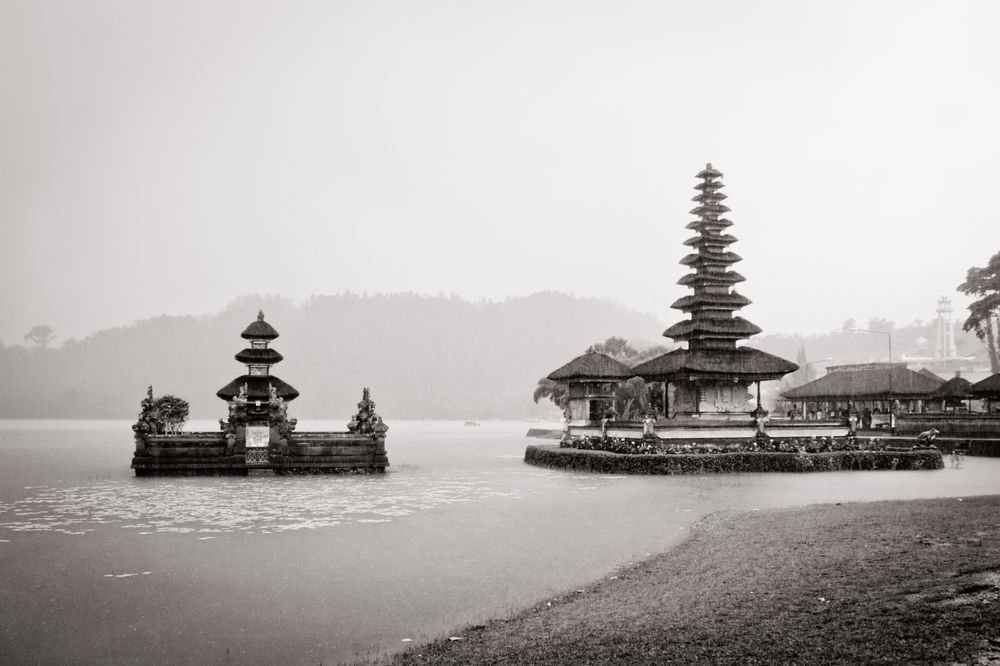
Pura Ulun Danu Bratan – Bali island
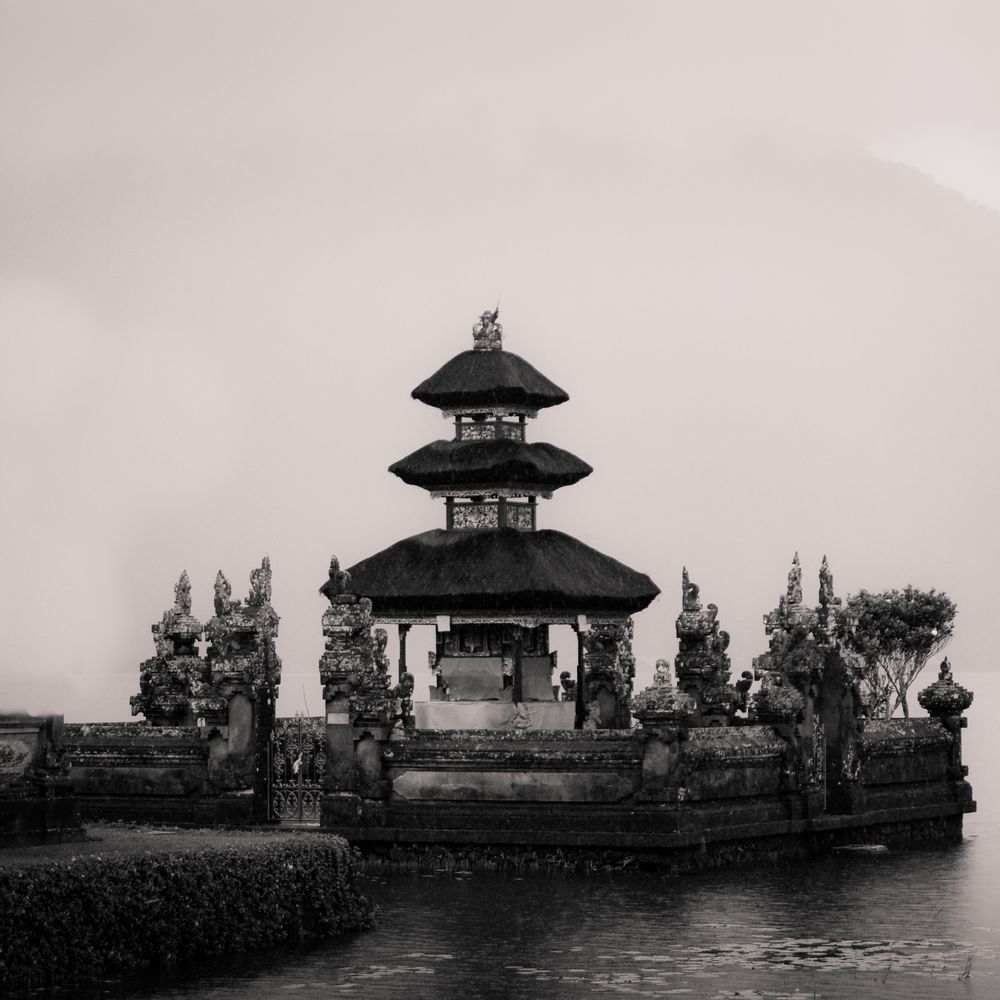
Pura Tanah Lot
Located in the south coast of Bali in Beraban , Tabanan district, , around 20km north west of Denpasar, Pura Tanah Lot is one of the seven temple of the sea of Bali island. This another iconic site of Bali is particularly impressive with the temple build on rocks , shape by the tide of the sea. The name « Tanah Lot » in Balinese , itself, means « Land in the sea ».
The main deity of the temple is Dewa Baruna or Bhatara Segara, who is the sea god or sea power and these days
The buildings were built after religious figure Dang Hyang Nirartha’s sacred journey (tirtha yatra) to Bali in the fifteenth century. According to the legend , during his travels along the south coast he saw the rock-island’s beautiful setting and decided to rest there. Some fishermen saw him, and bought him gifts. Nirartha then spent the night on the little island. Later he spoke to the fishermen and told them to build a shrine on the rock, for he felt it to be a holy place to worship the Balinese sea gods.
Nirartha was the creator of the padmasana architecture in Balinese Hindu temples. He was a Shaivite religious figure in Bali and a Hinduu traveler These temples are considered by devotees to be the embodiment of the supreme Shiva. The temples on the coasts of Bali were augmented with the padmasana shrines by the dozen during the travels of Nirartha.
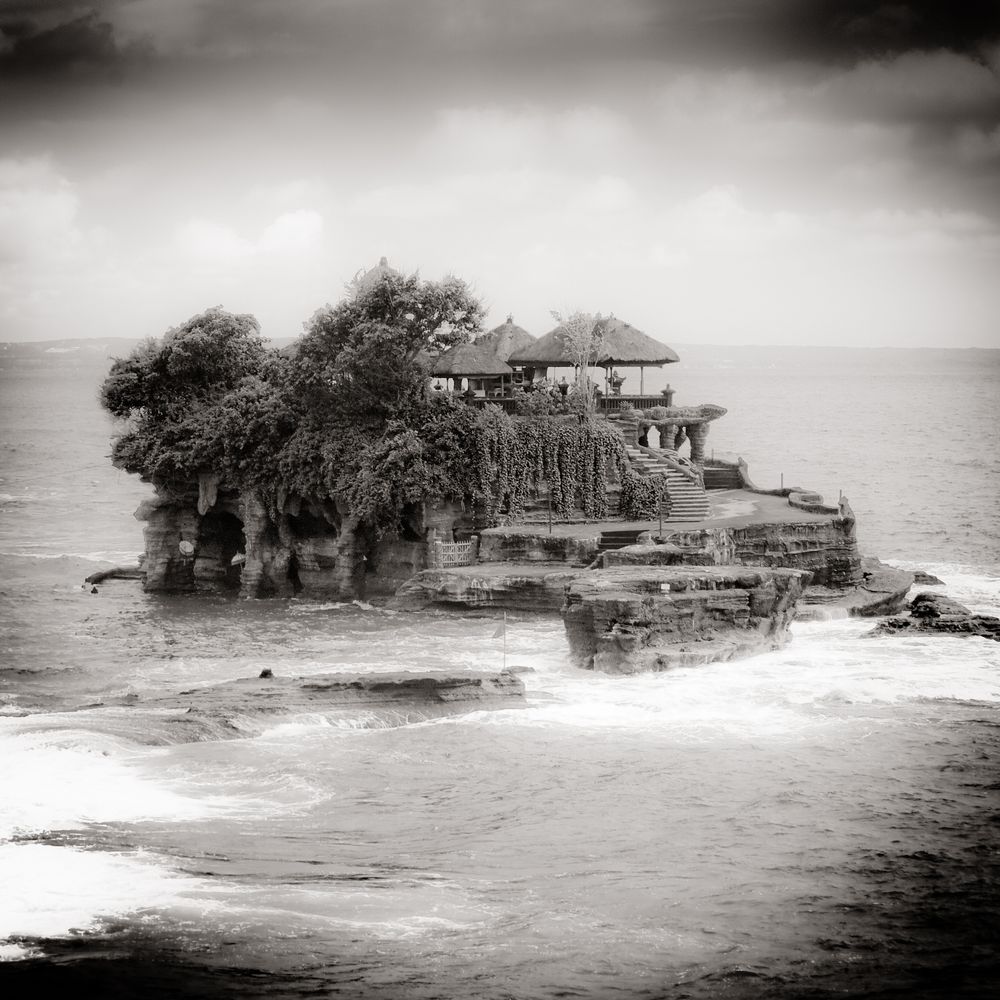
The temple was restored in the 80s and almost a third of the rock is artificial in order to protect the temple from the sea
Pura Batu Bolong
A few hundred meters north from Pura Tanah Lot, the temple of Pura Batu Bolong is also very photogenic. It is hung on a rock connected to the ground by an arch. Batu Bolong means the hole in the rock. It is also a hindhu temple.
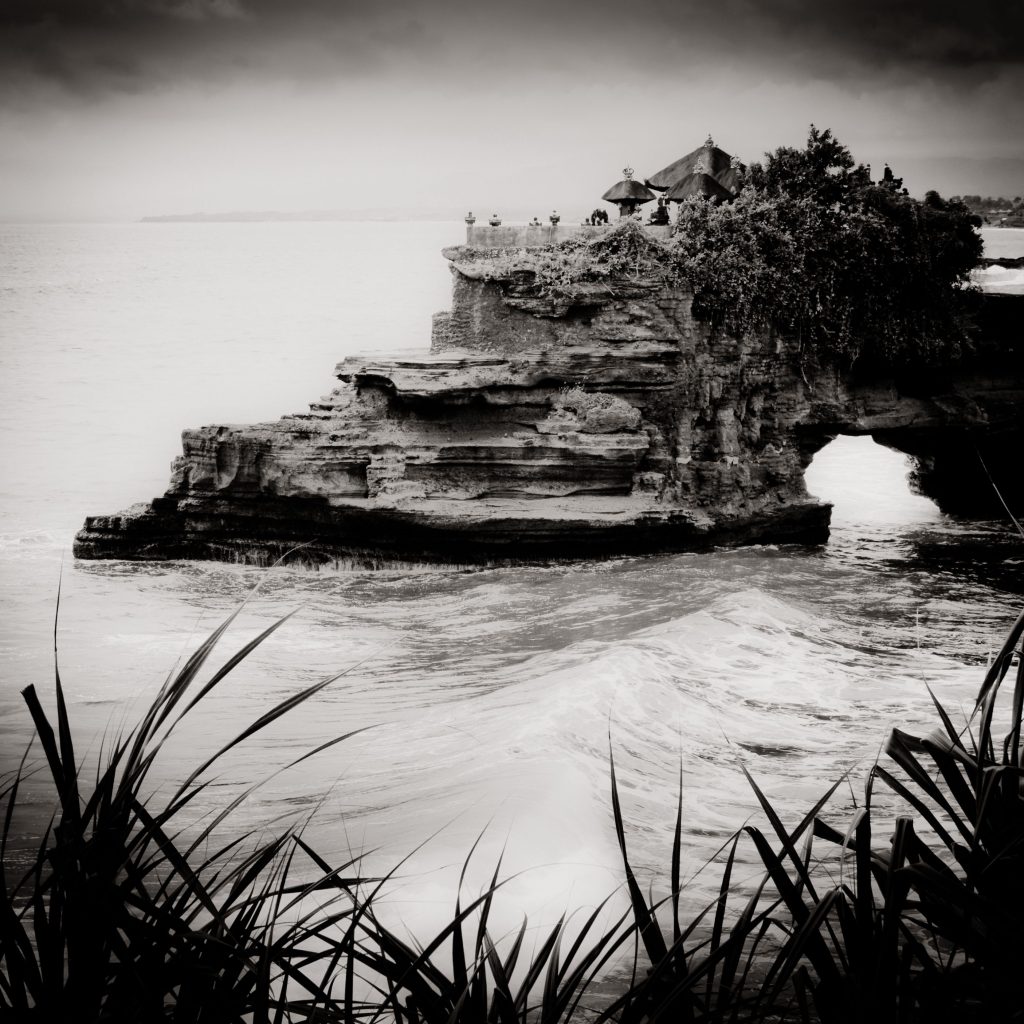
Pura Batu Bolong – Bali island – Temple of the sea
Kerta gosa (Taman Kertha Gosa )
Kerta Gosa was an ancient hall of justice. Located in the city of
Semarapura, the capital city of the Klungkung Regency in Bali in south-east of Bali. Approximately 20 km at the east of Ubud. It is also an example of Balinese architecture. It was built in the early 18th century .
Kertha Gosa was repainted in the 1920s and again in the 1960s. The Pavilion has a section of the Hindu epic Mahabharataa, called Bhima Swarga, depicted around the ceiling.
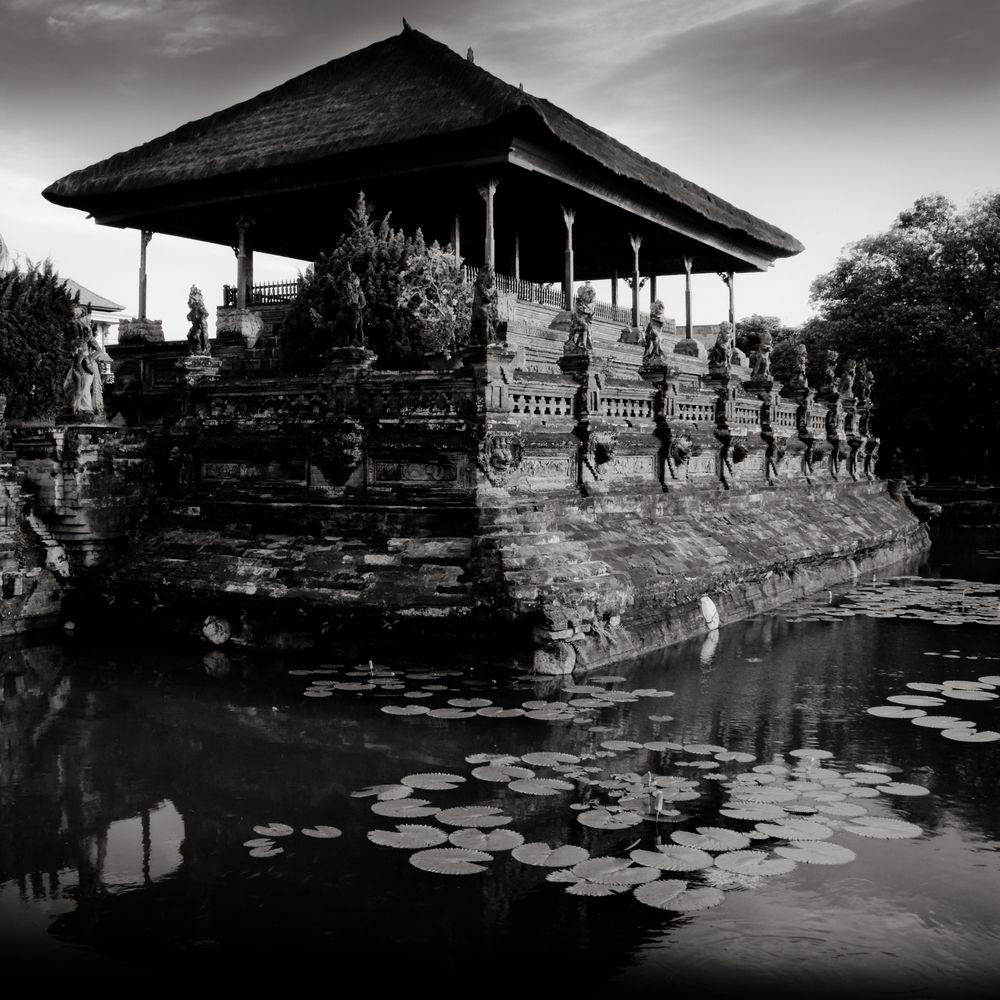
The ceiling of Kertha Gosa is painted in a traditional Balinese style that resembles wayang (puppet theatre)and are related closely to shadow theatre art. Iconography was to represent living things through pictures and shadows because it was prohibited to represent any living entity.
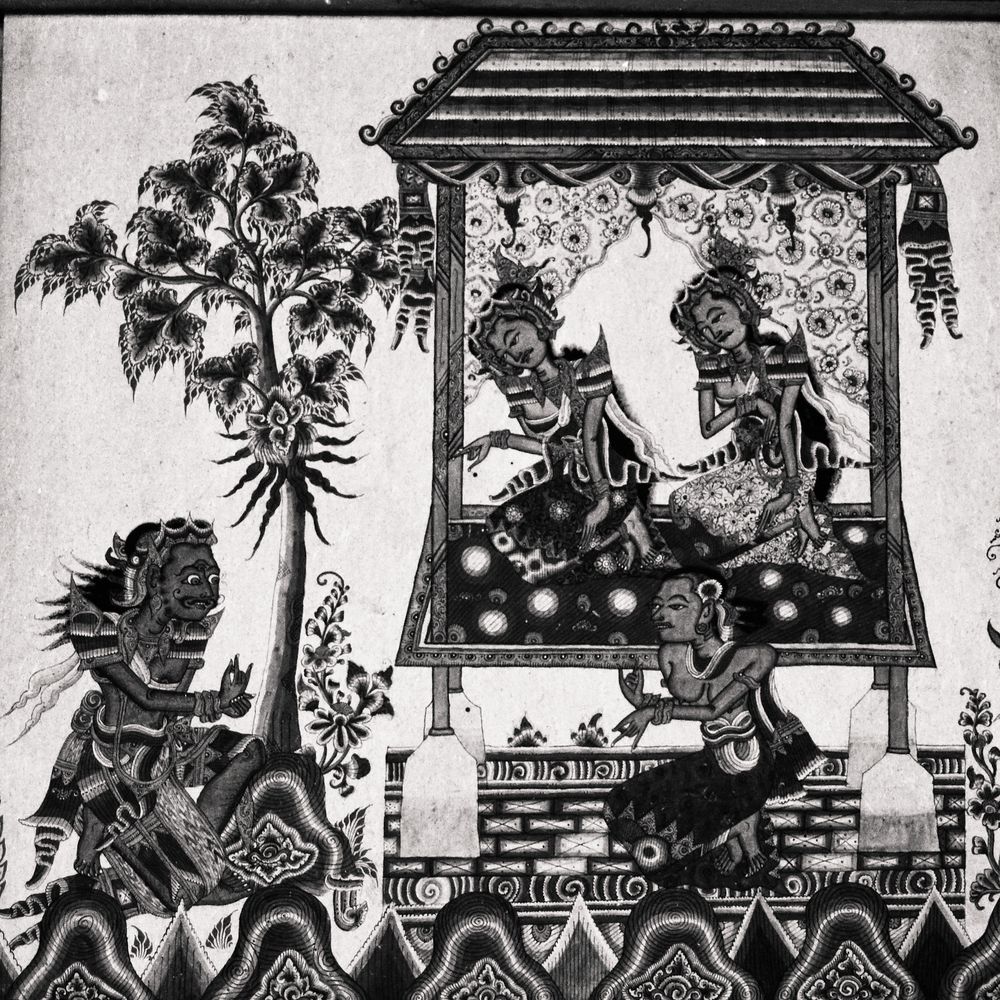
The pagoda of Mengwi – Pura Taman Ayun
A beautiful compounds of temples and gardens, Pura Taman Ayun is located in Mengwi, 15 km north from Denpasar.
This temple belongs to the UNESCO World Heritage as a part of the « Cultural Landscape of Bali Province: the Subak System as a Manifestation of the Tri Hita Karana Philosophy ». It is the second largest temple complex on Bali and his surround by moats filled with water.
Taman Ayun itself means ‘Beautiful Garden’. It was built by the king of Mengwi I Gusti Agung Putu in 1634, the temple was badly damaged in 1917 due to a devastating earthquake and was completely renovated in 1937.
The temple was a place of worship to the deified ancestors of the Mengwi dynasty but the Hindu gods were and are still also venerated here.
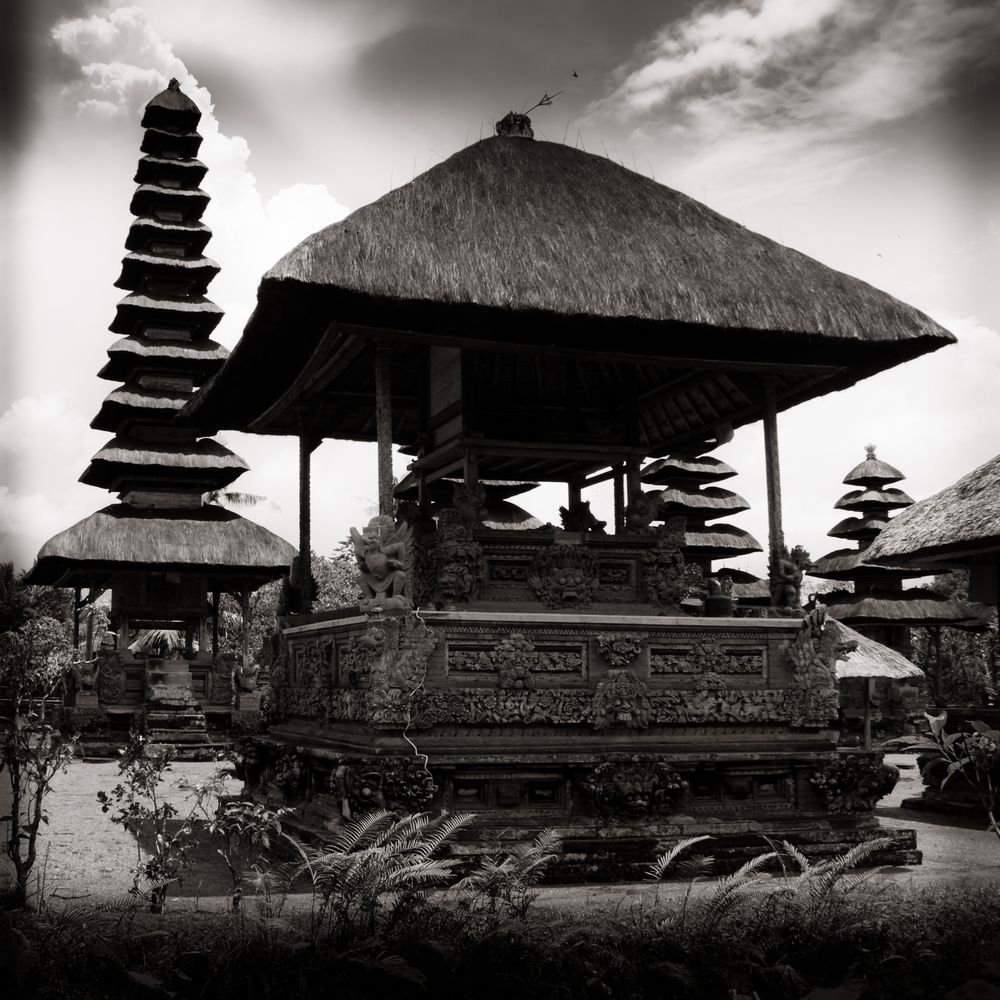
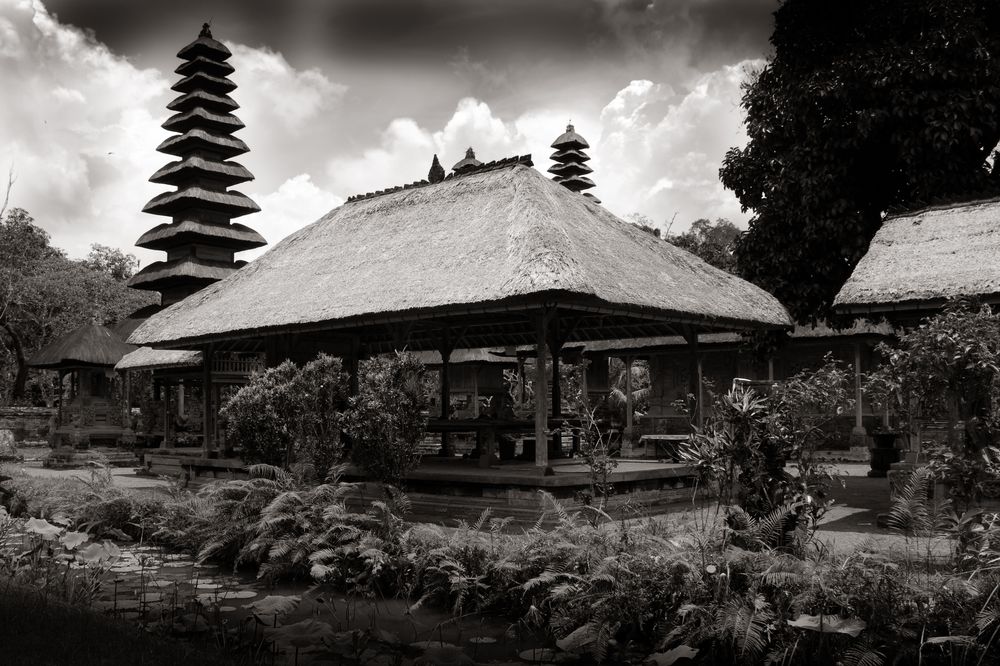
Gunung Kawi
The funeral monument and temple of the Gunung Kawi complex is located in the center of Bali island, nearly 20 km nork of Ubud in Tampaksiring district and not far from the Tirta Empul site. Gunung kawi was built in the eleventh century. It includes 10 Candi-shaped shrines carved into the cliff to a height of 7 meters. Its seems that these funeral monuments were dedicated to King Anak Wungsu of the Udayana dynasty and his favourite queens.
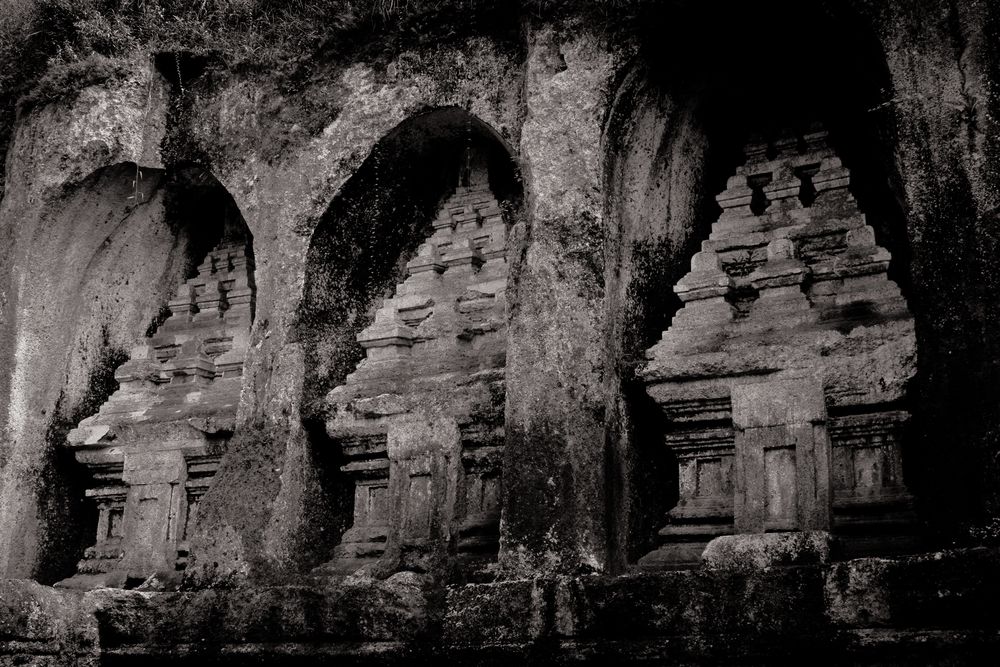
Candi : the name candi or candida comes from the demonic and destructive form of the goddess Shakti. In Hindu Balinese architecture, the term candi refers to a stone or brick structure of single-celled shrine with portico, entrance and stairs, topped with pyramidal roof and located within a pura. It is often modeled after East Javanese temples, and functions as a shrine to a certain deity.
Tirta Empul
One of my favorite spots in Bali, the temple of water of Tirta Empul is not only a very pretty temple, it is imbued with religious fervor with its ritual baths and Balinese indulging in ablutions. During our visit, we were also able to take a bath and share ablutions with the Balinese. The fresh water comes from a spring that the Balinese consider holy. Tirta empul is located in the Tampaksiring area, precisely on Jalan Tirta, Manukaya at around 1.5 hour drive from Denpasar or 30 minutes from downtown Ubud.
The hindhu temple is dedicated to Vishnu and was built in the 10th century during the Warmadewa dynasty. It has 3 sections : Jaba Pura (front yard), Jaba Tengah (central yard) with ponds and Jeroan (inner yard) where worshippers will pray and set offerings . The name of Tirta Empul would mean « water gushing from the ground ».
For the ablution, the local residents often practice the Melukat tradition there. Melukat is a tradition of purification in Tirtha Empul, done in the pond of Jaba Tengah, the central yard which contains 2 pools with 30 showers . This tradition attracts many visitors, both local and foreign. The Melukat tradition is considered by Balinese Hindus to have many benefits. This activity is said to be able to cure various illnesses, such as toothache, rheumatism and gout, and some believe that the Melukat tradition can also facilitate sustenance and find a companion.
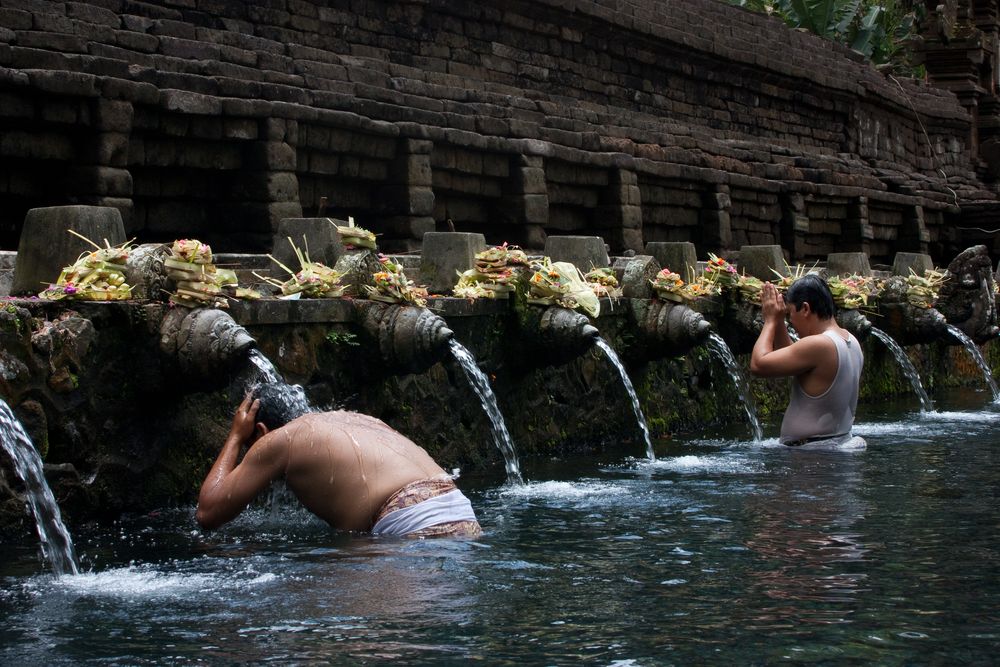
There is also a very colorful Koi carp pond, some very large, that you can feed.
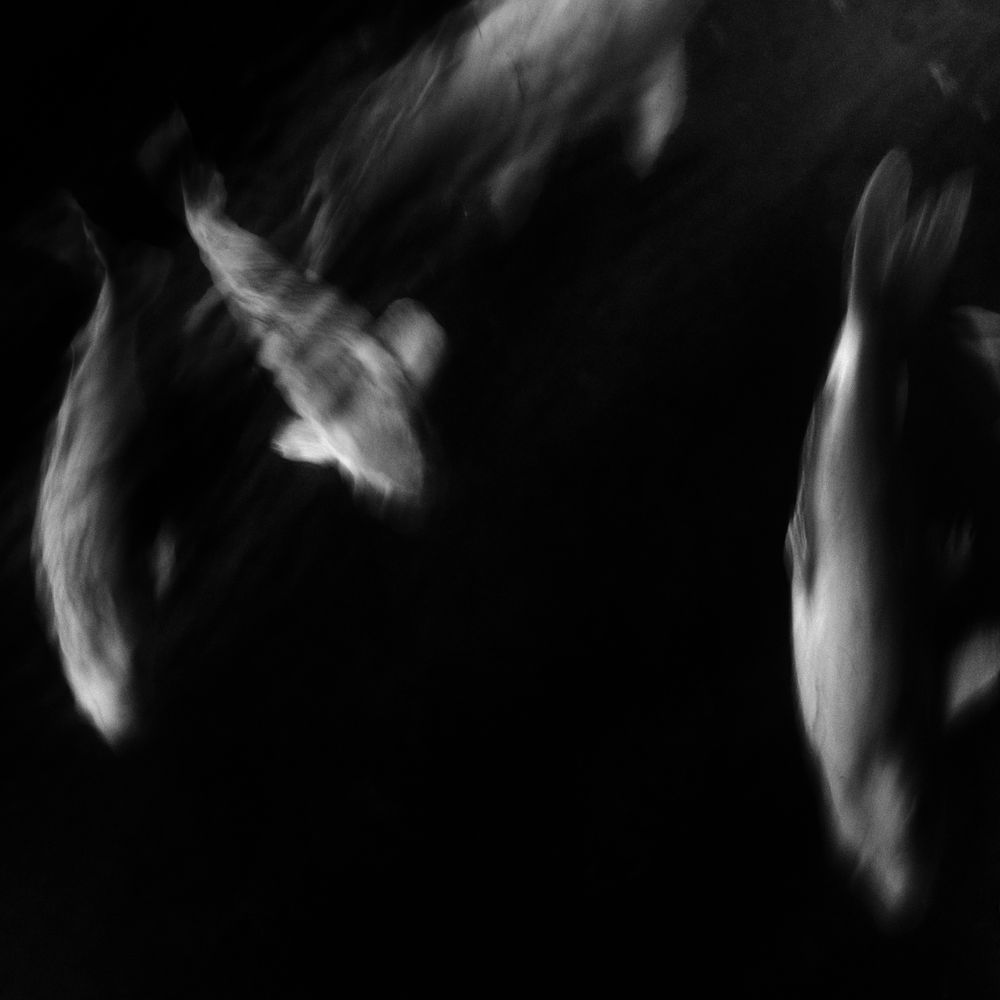
Legend : It is said that Mayadenawa, a powerful king who has evil traits, always disturbs people’s lives. Because he was evil, a man named Kulputih prayed and begged the god Indra for the god Indra to fight and eradicate King Mayadenawa. Until the day the god Indra sent troops to destroy Mayadenawa. This war ended with the defeat of Mayadenawa who then fled into the forest. Then Mayadenawa created a poisonous source and managed to kill some of Lord Indra’s troops. The God eventually created an antidote spring and named it Tirta Empul, which means holy water. After Mayadenawa discovered that his plan had failed, he returned to continue his escape, changing his form into a large rock, but the god Indra found his hiding place, and the god Indra immediately shot Mayadenawa dead. The murder of King Mayadenawa is still commemorated by Balinese Hindus every 210 days, known as Galungan Day.
You can combine the visit of Tirta Empul with the burial site and temple of Gunung Kawi not far away
Mount Batur
Following the visit of the Pura Besakih temple, we reach the mount Batur in the afternoom, covered by clouds. Mount Batur is an active volcano in the North East of the Bali island. It is bordered by the Danau Batur lake. This lake is contained in one of the 2 calderas of the volcano, the larger one caldera of 10×13 km which collapsed 29 000 years ago. The mount Batur itself is inside the smaller caldera of 7.5 km which collapsed around 20 000 years ago. Its elevation is 1717 meters.
UNESCO made Mount Batur Caldera a part of the Global Geoparks Network in 2012 which seeks the promotion and conservation of the planet’s geological heritage, as well as encourages the sustainable research and development by the concerned communities .
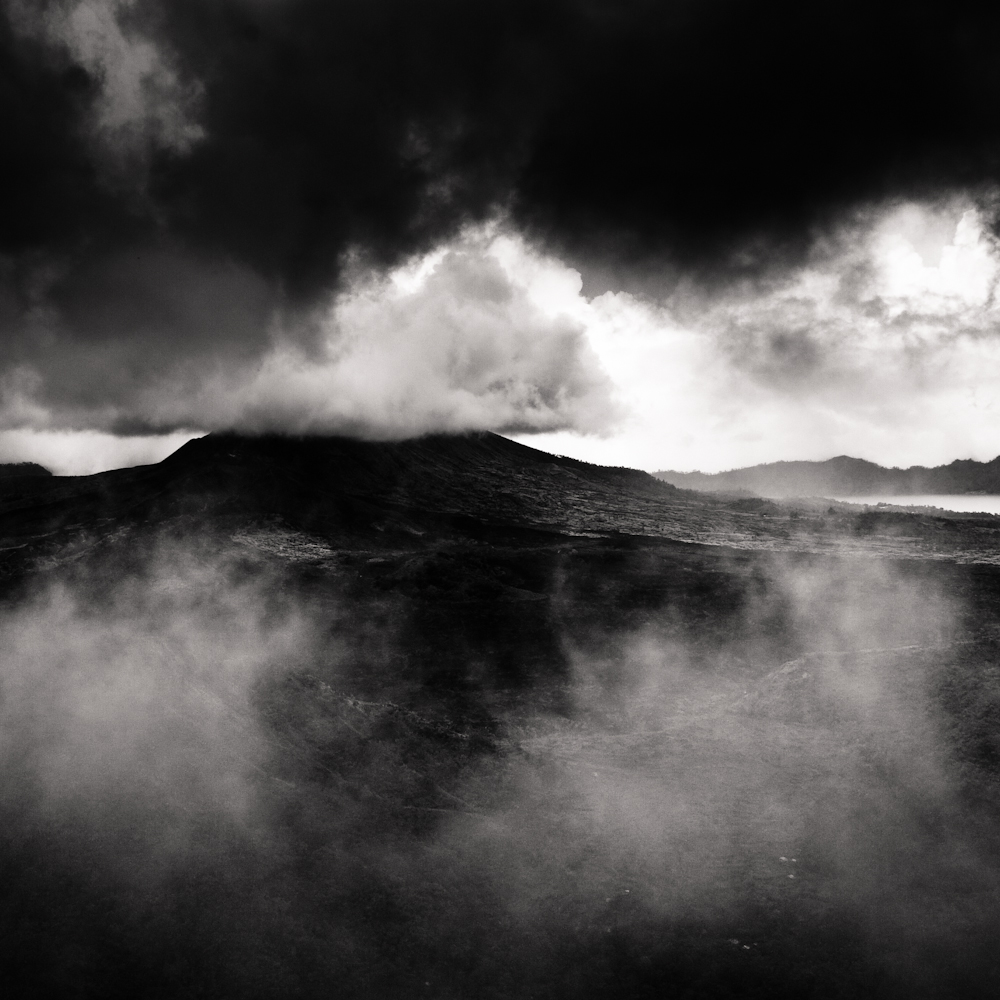
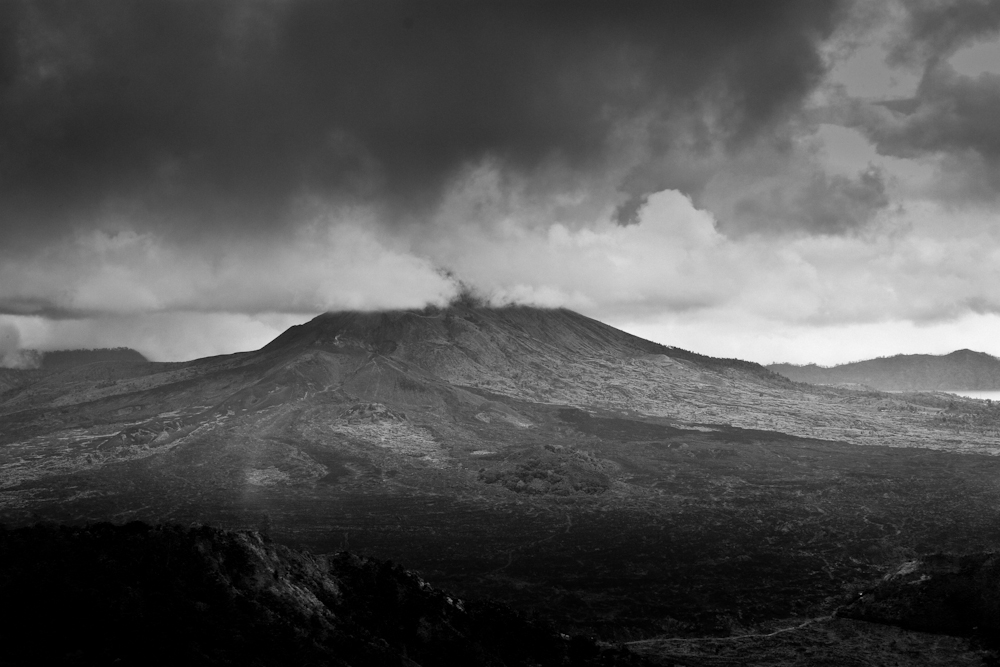
Pura Luhur Batukaru temple
We visited the Pura Luhur Batukaru temple during the same day trip as the Jatiluwih rice fields. This temple is also a Hindhu temple and is located on the southern side flank of the Batukaru Volcano, the second largest volcano on the island. Specifically the temple is located in Wongaya Gede village in the Tabanan province at an altitude of 833 m above sea level. The temple was originally built in the 11th century but was destroyed in 1604 and finally rebuilt recently in 1959. Pura Luhur Batukaru was dedicated to the ancestors of the king of Tabanan. Today one of the most important elements of the temple is a shrine of 7 aligned Meru towers , dedicated to Mahadewa .
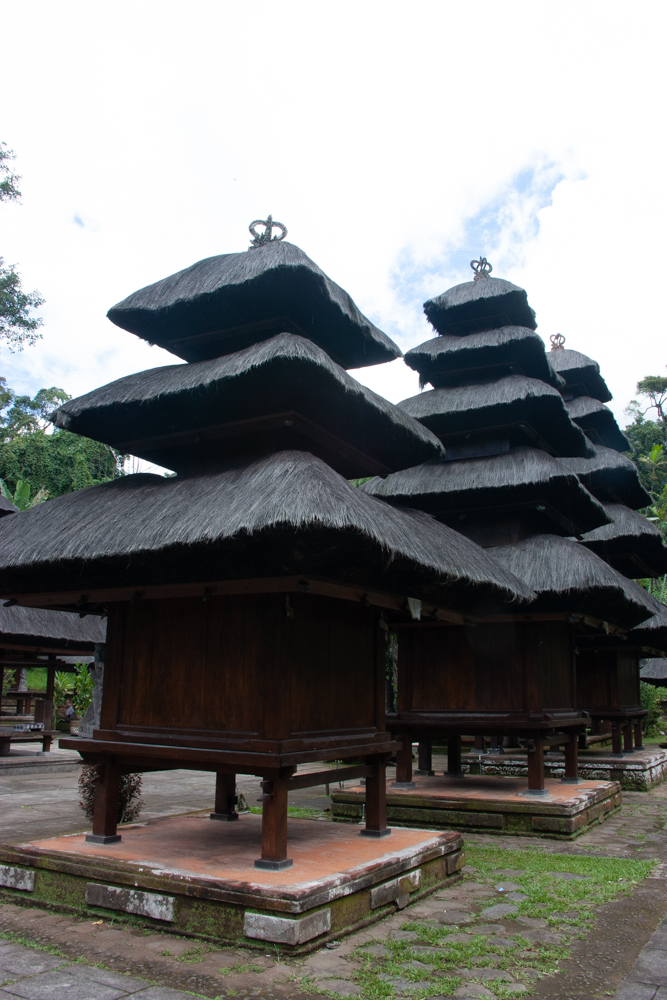
Tegallalang Rice Terrace
Ubud
Surrounded by rice paddies, we choose to stay in this city during your trip to Bali. Ubud is an excellent central point for discovering Bali. Despite it receives a lots of tourists every year, we feel more relaxing here than Kuta. Numerous museums, arts and crafts galleries abound in the city.
Don’t forget to visit the Monkey Forest in the south of the city.
Glossary
Candi bentar, or split gateway, is a classical Javanese and Balinese gateway entrance commonly found at the entrance of religious compounds, palaces, or cemeteries in Indonesia. It is basically a candi-like structure split perfectly in two to create a passage in the center for people to walk through.
A Meru tower or pelinggih meru is the principal shrine of a Balinese temple. It is a wooden, pagoda-like structure with a masonry base, a wooden chamber and multi-tiered thatched roofs. The height of Meru towers represent the Hindu Mount Meru.
References to Places To Visit In Bali
Unesco Cultural Landscape of Bali Province: the Subak System as a Manifestation of the Tri Hita Karana Philosophy
wiki : Bali
Britannica : https://www.britannica.com/place/Bali-island-and-province-Indonesia
Bali Discovery : http://www.balidiscovery.com/
Info Indonésie : http://www.infoindonesie.com/
Inside Indonesia : http://www.insideindonesia.org/
Pura Ulun Danu Beratan : http://www.bali-indonesia.com/attractions/ulun-danu-beratan-temple.htm
Kerta Gosa : http://www.thebalitoday.com/news/kerta-gosa/
Pura Luhur Batukaru : https://kebudayaan.kemdikbud.go.id/bpcbbali/pura-batukaru-batukau-desa-wongaya-gede-tabanan/
https://www.babadbali.com/pura/plan/batukaru.htm
Pura Besakih : https://disparda.baliprov.go.id/besakih-temple/2020/04/#:~:text=Bali%20Besakih%20Temple%20is%20the,from%20all%20over%20the%20world.
Going more far
FAQ Places to visit in Bali
Why not Kuta ?
Kuta is really too western, luxury stores and others lining up one after the other to vomit. For us, this is the place to avoid if possible.
Complements to Places to Visit in Bali :
You may be interested by this article :
